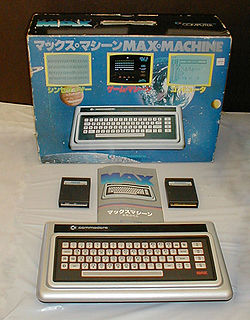
Commodore MAX Machine
Encyclopedia
The Commodore MAX Machine, also known as Ultimax in the United States
and VC-10 in Germany
, was a home computer
designed and sold by Commodore International
in Japan
, beginning in early 1982, a predecessor to the popular Commodore 64
. The Commodore 64 manual mentions the machine by name, suggesting that Commodore intended to sell the machine internationally; however, it is unclear whether the machine was ever actually sold outside of Japan. It is considered a rarity.
Software was loaded from plug-in cartridges and the unit had a membrane keyboard and 4.0 KiB of RAM internally (2 KiB available in BASIC) and 0.5 KiB of color RAM (1024*4bit). It used a television set for a display. It used the same chipset and 6510
CPU as the Commodore 64, the same SID
sound chip, and compatible ROM cartridge architecture so that MAX cartridges will work in the C-64. The MAX compatibility mode in C-64 was later frequently used for "freezer" cartridges (such as the Action Replay), as a convenient way to take control of the currently running program. It was possible to use a tape drive for storage, but it lacked the serial and user ports necessary to connect a disk drive, printer, or modem.
 It was intended to sell for around 200 USD. Although the MAX had better graphics and sound capability, Commodore's own VIC-20
It was intended to sell for around 200 USD. Although the MAX had better graphics and sound capability, Commodore's own VIC-20
, which sold for around the same amount of money, was much more expandable, had a much larger software library, and had a better keyboard—all of which made it more attractive to consumers.
Unlike the C-64, the MAX never sold well and was quickly discontinued.
United States
The United States of America is a federal constitutional republic comprising fifty states and a federal district...
and VC-10 in Germany
Germany
Germany , officially the Federal Republic of Germany , is a federal parliamentary republic in Europe. The country consists of 16 states while the capital and largest city is Berlin. Germany covers an area of 357,021 km2 and has a largely temperate seasonal climate...
, was a home computer
Home computer
Home computers were a class of microcomputers entering the market in 1977, and becoming increasingly common during the 1980s. They were marketed to consumers as affordable and accessible computers that, for the first time, were intended for the use of a single nontechnical user...
designed and sold by Commodore International
Commodore International
Commodore is the commonly used name for Commodore Business Machines , the U.S.-based home computer manufacturer and electronics manufacturer headquartered in West Chester, Pennsylvania, which also housed Commodore's corporate parent company, Commodore International Limited...
in Japan
Japan
Japan is an island nation in East Asia. Located in the Pacific Ocean, it lies to the east of the Sea of Japan, China, North Korea, South Korea and Russia, stretching from the Sea of Okhotsk in the north to the East China Sea and Taiwan in the south...
, beginning in early 1982, a predecessor to the popular Commodore 64
Commodore 64
The Commodore 64 is an 8-bit home computer introduced by Commodore International in January 1982.Volume production started in the spring of 1982, with machines being released on to the market in August at a price of US$595...
. The Commodore 64 manual mentions the machine by name, suggesting that Commodore intended to sell the machine internationally; however, it is unclear whether the machine was ever actually sold outside of Japan. It is considered a rarity.
Software was loaded from plug-in cartridges and the unit had a membrane keyboard and 4.0 KiB of RAM internally (2 KiB available in BASIC) and 0.5 KiB of color RAM (1024*4bit). It used a television set for a display. It used the same chipset and 6510
MOS Technology 6510
thumb|300px|Image of the internals of a [[Commodore 64]] showing the 6510 CPU . The chip on the right is the [[MOS Technology SID|6581 SID]]...
CPU as the Commodore 64, the same SID
MOS Technology SID
The MOS Technology 6581/8580 SID is the built-in Programmable Sound Generator chip of Commodore's CBM-II, Commodore 64, Commodore 128 and Commodore MAX Machine home computers...
sound chip, and compatible ROM cartridge architecture so that MAX cartridges will work in the C-64. The MAX compatibility mode in C-64 was later frequently used for "freezer" cartridges (such as the Action Replay), as a convenient way to take control of the currently running program. It was possible to use a tape drive for storage, but it lacked the serial and user ports necessary to connect a disk drive, printer, or modem.

Commodore VIC-20
The VIC-20 is an 8-bit home computer which was sold by Commodore Business Machines. The VIC-20 was announced in 1980, roughly three years after Commodore's first personal computer, the PET...
, which sold for around the same amount of money, was much more expandable, had a much larger software library, and had a better keyboard—all of which made it more attractive to consumers.
Unlike the C-64, the MAX never sold well and was quickly discontinued.
External links
- Page dedicated to the MAX Machine
- [ftp://ftp.zimmers.net/pub/cbm/c64/html/ultimax.html Informations about the MAX]
- The MAX Machine, the odd one out

